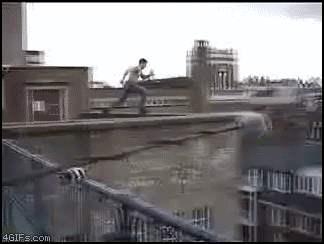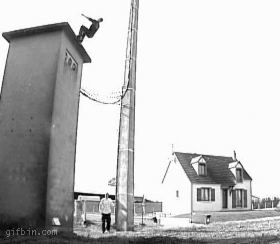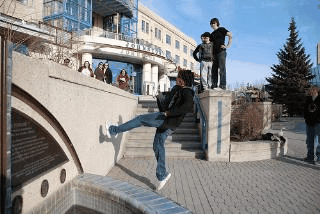|
|
|||||||||||||||||||||||||||||||
|
Parkour and Freerunning
The Ultimate Urban Obstacle Course
By Christine Stoesser - May 2011. Editor's Note: It may take awhile for the moving GIFs to load, depending on your connection speed. Last night I saw a concert with some friends. We danced for the duration of their 1.5 hour set, and when they finished we clapped and hollered, then ran outside to smoke cigarettes. Soon throngs of Toronto twentysomethings began to pour out of the Phoenix, and it wasn’t long before we heard an all- too-familiar question: “Hey—do you have an extra cigarette, by any chance?” I had already reached into my purse, but one of my friends wanted to make him work for it. “Not unless you hang from that branch right there,” he said, indicating a 15-foot high branch that extended over the sidewalk. Our new acquaintance accepted, but he just couldn’t jump high enough. Then he attempted to scale up the trunk of the tree, but his shoes just weren’t gripping. Awkward. After receiving a boost from another of my friends, he was able to finally get a grip on the branch and swing a little, north to south, over the Sherbourne St. sidewalk. While he was up there the few passersby who strolled underneath him did not look impressed; two rolled their eyes and another said, “So immature.”
Parkour This mediocre display got me thinking about Parkour, a fairly recent international phenomenon. Parkour is a physiological discipline that focuses on pure freedom of movement in one’s environment (wherever that may be) as one moves from Point A to Point B in as fast and efficient a manner as possible. Parkour is sometimes erroneously called an extreme sport; while it cannot be denied that it is extreme, it is important to note that Parkour is non-competitive, yet designed to heighten one’s instinct for self-preservation. Originating in France, practitioners of Parkour are called ‘traceurs’ and they employ a wide range of techniques such as: running, jumping, climbing, vaulting, wall scaling, etc. While it is not necessary to practice Parkour in an urban setting, a metropolis is ideal with all its flat rooftops, railings and obstacles in general. Parkour and Creativity
It’s curious how people define creativity. Many of my friends are artsy types and in most cases define creativity as the ability to produce a unique product in a recognizable format such as a painting, film, design or record. Conversely, I’ve heard the opinion that a woman’s ability to conceive and produce life is the essence of creativity. Physical activity, however, is rarely viewed as a creative enterprise; in fact, words like “dumb jock” and “meathead” get hardwired into adolescent brains and cause negative associations to accompany the prototype of a person who puts high priority on physical fitness. Parkour dispels these notions—it is, in its fundamental nature, about the creativity of movement, of the body and of the physical world. "If you are in front of a wall that you cannot get past, would you just keep banging your head into the wall?... No, you would find a new wall,” says David Belle, the founder of Parkour. Traceurs are unanimous in their claim that the creative problem solving skills they test and improve every day in their training don’t take long to incorporate themselves into other aspects of life. Belle says, “Obstacles are found everywhere, and in overcoming them we nourish ourselves.” Parkour, it seems to me, is a workout, a jam session and one of those weekend leadership workshops people pay thousands for all (run, jumped and) rolled into one. Do You Want to Play?
The fearless stunts that experienced traceurs pull off sometimes cause the activity to be improperly labeled as anarchic. This couldn’t be further from the philosophical ideal Parkour stems from, which is to integrate with the physical world through touch and interaction, to rediscover what it means to be human and to occupy a physical body. Dan Iaboni, who runs The Monkey Vault Parkour and Freerunning Training Centre in Toronto, said in a 2007 interview, "The roots of movement were outside, you know, they weren't inside a gym on a treadmill or an elliptical machine. To me that's not movement; I see people on treadmills and I think 'hamster'." Iaboni’s multi-purpose training centre is located on Geary Ave. in Toronto. The facility is home not only to equipment and instruction, but to a positive and hard-working community who, while they do literally ‘hang out’, have never stopped ‘playing’. "There's no reason why you can't be a child your whole life," Iaboni said in his CBC interview. "People do take life too seriously, and maybe through this they'll realize [everybody can] get out there and play." Parkour (not to be confused with freerunning, which is similar in principle but adds flips and twists for aesthetic appeal) may not be for everyone, but it could be. So many people (myself included) have lost touch with the natural environment that we have shut-ins, obesity epidemics, eating disorders, nicotine addicts and twentysomethings too “grown up” to consider climbing a tree, let alone strong enough. We need people like David Belle to remind us what people like us are capable of. Parkour is about improving on a daily basis, of that being its own reward—what’s immature there? Parkour Videos
See Also
|
|
||||||||||||||||||||||||||||||
|
Website Design + SEO by designSEO.ca ~ Owned + Edited by Suzanne MacNevin | |||||||||||||||||||||||||||||||



